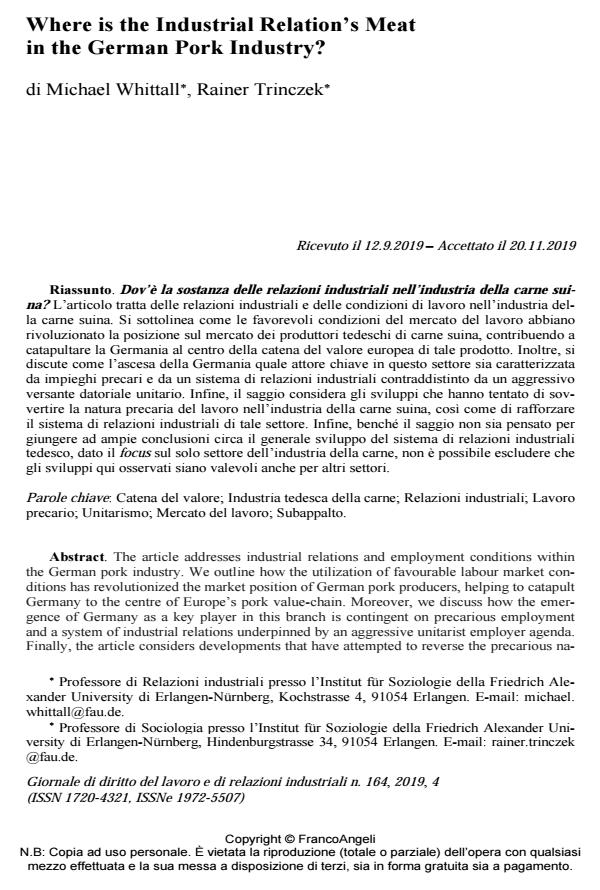Where is the Industrial Relation’s Meat in the German Pork Industry?
Journal title GIORNALE DI DIRITTO DEL LAVORO E DI RELAZIONI INDUSTRIALI
Author/s Michael Whittall , Rainer Trinczek
Publishing Year 2020 Issue 2019/164
Language English Pages 18 P. 695-712 File size 276 KB
DOI 10.3280/GDL2019-164005
DOI is like a bar code for intellectual property: to have more infomation
click here
Below, you can see the article first page
If you want to buy this article in PDF format, you can do it, following the instructions to buy download credits

FrancoAngeli is member of Publishers International Linking Association, Inc (PILA), a not-for-profit association which run the CrossRef service enabling links to and from online scholarly content.
The article addresses industrial relations and employment conditions within the German pork industry. We outline how the utilization of favourable labour market conditions has revolution-ized the market position of German pork producers, helping to catapult Germany to the centre of Europe’s pork value-chain. Moreover, we discuss how the emergence of Germany as a key player in this branch is contingent on precarious employment and a system of industrial rela-tions underpinned by an aggressive unitarist employer agenda. Finally, the article considers developments that have attempted to reverse the precarious nature of employment in the meat industry as well as strengthen industrial relations procedures. Finally, although the article is not designed to make sweeping statements about wider developments within the German in-dustrial relations system, being the focus on one particular sector, the meat industry, we cannot exclude that developments presented here could serve as a warning to other sectors.
Keywords: Value chain; German meat industry; Industrial relations; Precarious employment; Unitarism; Labour market; Subcontracting.
- Im Osten was Neues? Ingrid Artus, Andreas Fischer, Judith Holland, Michael Whittall, in PROKLA. Zeitschrift für kritische Sozialwissenschaft /2023 pp.245
DOI: 10.32387/prokla.v53i211.2046 - Tendenze delle relazioni industriali nel settore suinicolo: il caso italiano in un quadro europeo Giulio Centamore, Davide Dazzi, in GIORNALE DI DIRITTO DEL LAVORO E DI RELAZIONI INDUSTRIALI 165/2020 pp.57
DOI: 10.3280/GDL2020-165003 - Allemagne. Les stratégies d’IG Metall en matière de négociation collective : à l’est, rien de nouveau ? Michael Whittall, Ingrid Artus, Andreas Fischer, Judith Holland, in Chronique Internationale de l'IRES /2023 pp.67
DOI: 10.3917/chii.183.0067
Michael Whittall , Rainer Trinczek, Where is the Industrial Relation’s Meat in the German Pork Industry? in "GIORNALE DI DIRITTO DEL LAVORO E DI RELAZIONI INDUSTRIALI " 164/2019, pp 695-712, DOI: 10.3280/GDL2019-164005